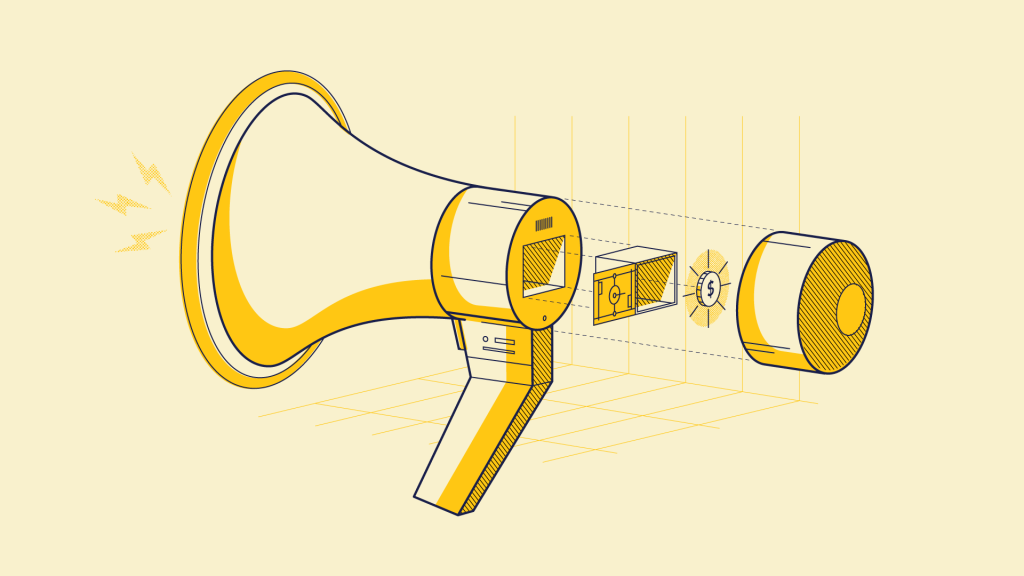Brand-Tier Marketing
Maximize Wins and Minimize Losses with a Healthy Advertising Mix
Your bank needs deposits. Everyone from the top down knows it. After a spirited ALCO meeting, the bank agrees to roll out a high-yield CD to bring in the bucks. You get a special budget to create a 90-day campaign with new creative. You pull off the miracle of launching the campaign in the nick of time.

Across town, a person is opening her newspaper, and your ad catches her eye. She’s looking for a new bank, after all. But…it’s for a CD. She owns a business and is looking for a place to move her operating account—that holds about $500,000 on average. Even though she’s unhappy with her current bank, she breezes right on past your ad because it doesn’t fit her need. You see, she needs a business bank.
What’s this? Your bank is also a commercial bank?
Of course, it is, but you missed the opportunity because the mandate was to advertise the high-yield CD.
Ugh. It’s a bit of a gut punch, right?
It’s a mistake you might’ve made (and now you’re probably trying to think of how many times). The ad was too focused—when the business owner in question could’ve put a big dent in your deposit-raising goal with her operating account.
I don’t have a problem with CD ads. I don’t have a problem with product-based promotions. Each has its place in your marketing plan.
But this scenario reminds me of something I heard an old man relate once: “You can bet your bottom dollar I’ll be at the airport when my ship comes in.”
It’s maddening to be given a great product, executed a campaign, and know you still might’ve missed the proverbial boat.
The scenario outlined above plays out at banks all across the country—multiple times every day.
A person is looking for a mortgage when you’re running an ad for your new checking account.
A student is looking for a new checking account and receives a digital ad for mortgage.
Your audience is simply bigger, broader, and more diverse than most banks’ ad campaigns. There is no way to match the perfect ad with precise timing to the exact needs of a potential client.
Don’t despair, though. There is a solution.
Turning Tears into Tiers
Before we dig into the “how,” you must distance yourself from two core fallacies that hold back banks:
❌ The only way to attract a person to a bank product is to advertise that bank product.
❌ You don’t have enough resources to do what you need to do.
You have the distinctly difficult task of promoting an incredibly complex product mix to an incredibly complex audience. If you approach the project head-on, you’ll wind up going in circles. I’m sure there are resources that claim to match exact need with a perfect ad*, but there’s a more reliable technique.
You have to divide your advertising into three tiers:
1. Brand
2. Transitional
3. Product
Tier One: Brand Advertising
The core of your advertising campaign must be based on your brand. Many times we commit 40% or more of an entire advertising budget to this portion. There are two facets to brand advertising: the message and the medium.
“Branding” as a verb is often misused (unless you’re talking about pressing a hot iron to a cow’s backside). Some purveyors of creativity try to convince an audience that a logo or brand can be so good that it “verbs” an audience in some ways. Make no mistake, though, the Nikes, Cokes, and Amazons of the world would still be stuck at the starting gates if not for an investment in advertising that promoted their brands. Neither would their names echo in the vaunted halls of branding if they didn’t spend BILLIONS backing their position. Sure, they’re great brands, but never forget that they bought the affinity they enjoy.
Brand Messaging
You must commit to advertising that promotes your brand position. If you haven’t arrived at this position, check out this piece or just fast-forward and hire us.
The short version is this: your bank is very similar to 99% of the other 12,000-13,000 financial institutions also marketing to your audience. You must find that 1% and advertise the hell out of it.
Consider this Mabus Agency mantra:
The role of advertising is to facilitate word of mouth in two ways:
1. To get people to talk
2. To tell them what to say
That’s the role of brand messaging. You want to make sure as many people as possible add something like this to their daily conversations: “Hey, have you heard of Strong Bank? Yeah, they’re strong. That’s why I do business with them.”
Brand Media
Once you’ve arrived at your message and committed to sharing it, you have to pick a media mix that fits. While there are no hard and fast rules, we do believe there are media that better lend themselves to certain areas of marketing. For brand, television, billboard, and other broadcast media often carry the biggest brand punch.
No one can choose your bank if they don’t know it exists. You must increase awareness of your brand name, and these agnostic, unfocused media are great tools in your arsenal to spread news of your name. Keep in mind, your brand messaging is only part of the whole. We’ll need to layer in other messaging and tactics.
Tier Two: Transitional Advertising
Being a middle child is tough. One exists as a comparison to older and younger siblings. So is the case with the middle child of our brand-tier approach. You probably can guess that Tier 3 (Product) will be pretty straightforward. Like the youngest sibling, Product is often the baby. And, as we’ve already covered, Brand is the eldest—guiding all our actions.
Transitional Messaging
Transitional is just what the name conveys: the space between the two. But it is definable. Transitional ads outline, with more depth, what type of bank you are.
This could be focused down a line of business:
We’re a commercial bank.
We’re a retail bank.
We’re a mortgage bank.
Perhaps it’s more philosophical:
We’re a community bank.
We’re a bank that crusades for a cause.
We’re a bank that supports our community.
Whatever your bank is, you need to communicate that to your audience early and often.
Transitional ads translate what can be esoteric ideas into more digestible principles for your consumer.
And think of this generally—like the examples above. You can be multiple things in multiple media.
Transitional Media
Again, there are no hard and fast rules, but you can concentrate your Transitional messaging pretty easily. Magazines and specialty publications can be a great forum. If you’re an ag bank, look to your farming publications. Business journals can showcase your position as a business bank. While I’m not a huge fan of radio, there are opportunities (especially in ag territories) to match messaging with medium in powerful ways. Another often overlooked opportunity is events. You can sponsor focused events in agriculture, business, and real estate, or you can level up: make your own. It can be a bit tough to pull off, but there’s no replacement for building relationships. Instead of creating advertising to get someone to walk into your bank, create advertising to draw a farmer or business person to a low-commitment event with a highly valuable speaker. You’ll be thanked for your effort, and likely some of that appreciation will turn into business.
Tier Three: Product Advertising
You probably don’t need a lesson here. We’ve all done plenty of this. It’s the safe route. You’ll never get called on the carpet for promoting product. The only other safe option is putting bankers’ pictures in the paper, but we’re not even going to go there.
Product Messaging
As I said earlier, product advertising has its place. That place is using about 20-30% of your budget to sell a product directly. And when I say “direct,” I mean it.
When you have the properly tiered advertising strategy, you can go in hard on product messaging. You have to be a bit more clever than “Open a damn account now,” but not much. This is where you use your features (such as rate, cashback, etc.), but don’t forget to marry these with your brand benefit.
Product Media
You can advertise product in any almost any media, but you won’t be able to get everything you want in the proper mix. I would guess your biggest fear is how thin your budget is getting by Tier Three. Therefore, you must concentrate where you can.
At the end of the day, your success will likely be quantified in product conversions. To that end, pick media that are extremely conversion-centric. Think digital(ly). Digital display and pay-per-click are areas where you can concentrate strong, straightforward brand messaging. Beyond this, you must have landing pages that match the campaign creative, offer, and messaging. Don’t buy digital ads and drop them on your bank’s homepage. Don’t drop visitors on your standard account signup page. Create unique pages that provide continuity and context from the brand that intrigued the person to click.
Lean Into Your Audience’s Knowledge Understanding
Your audience doesn’t know how a bank works (as we explain here), but they do know what a bank does.
This is especially true of those whose need is the most critical. When a client needs a loan or a new checking account, they know they need a bank. And these are the people you need to attract most.
Think about it. When have you heard someone say, “I need a new checking account”?
It’s more like, “My bank’s app has been wonky for the past six weeks. I need a new bank.”
So which bank will they visit?
One Brand to Rule Them All
You must take a second, close your eyes (if you’re listening to the blogcast), and imagine with me: each of these items must be congruent in messaging, tone, personality, color, photography style—in short, brand. They must look alike. They must sound similar. They must match. Keep in mind, though, I said “congruent.” This means in harmony, but not exact. This is called “Brand-Tier.” Each tier must be ON brand, but you can also use the unique attributes of each medium to great effect.
Hyperfocused, Under-resourced, and Overreacting
All banks have limited resources. There never is enough budget to do everything you want. The result is usually a frantic catch-up game.
We need deposits! Marketing shifts all its focus, time, and money to deposits.
Holy cow! What happened to lending? We need loans! Marketing shifts all its focus, time, and money to loans.
God forbid another bank rolls out a competitive rate. Then you’ll chase them.
To stop, you need a plan, and the Brand-Tier approach is one way to do it.
You don’t have to, and shouldn’t, chase.
Because when you’re chasing, you might not lose, but I can guarantee you won’t win.
Footnote: Remember the lesson, “if it seems too good to be true, it probably is.”)


